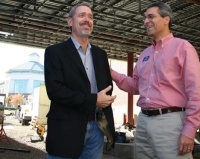Fort Smith Spends Millions on Downtown
by December 1, 2008 12:00 am 602 views

With about $50 million in redevelopment and restoration over the last four years, Fort Smith appears serious about bringing its downtown up to par.
The city has several major downtown projects climbing north of $1 million that will bring the 2008 tally to about $10 million, said Jayne Hughes, director of downtown development for the Central Business Improvement District Commission in Fort Smith.
Here’s a look at the projects in the historic city on Arkansas’ western border:
Much of the humming of construction along Garrison Avenue, the quasi-Main Street of downtown Fort Smith, can be traced to the intersection with Ninth Street, where a multi-building project brings more than one “first” to the area.
Arvest Bank expects to open its first downtown Fort Smith location in early January while another local developer prepares the area’s first condominiums next door.
“The attraction to this spot was both Rogers [Avenue] and Garrison frontage,” Arvest Executive Vice President Craig Rivaldo said. “And we had to be able to dump our drive-through traffic onto a street. And that’s very difficult to do if you don’t own the very corner lot.”
So Arvest bought the two-building property, modified the building on the corner of Ninth and Rogers to fit the company’s plans for a drive-through, then flipped it to local developer Rodney Ghan, principal broker of R.H. Ghan Commercial Properties of Fort Smith.
Ghan decided to turn the 15,400-SF building into the area’s first two condos – one for his own family and the other for his business partner, Darrell Robinson.
His investment, which will be called the Stuart-Daniel Lofts, totaled at about $1.5 million.
(According to Hughes, a couple of other condo projects for downtown Fort Smith are being discussed, but she wouldn’t divulge specifics.)
Arvest kept the other 10,000-SF building, of which it originally intended to use only the ground floor.
The company has since decided to use the top floor for office space.
The Arvest project, which will add about 30 employees to the area’s foot traffic, will end north of $2 million, Rivaldo said.
Arvest’s work on the exterior of the languishing building maintains the historic appearance of the area by using wood-framed windows and by not altering the façade.
“Our intent was to preserve as much of the façade and the exterior as we could” Rivaldo said, and Ghan added, “Because there wasn’t much of it left.”
Rivaldo noted that Arvest probably could have renovated the building much less expensively by dumping the old façade. (For instance, Arvest spent $1,800 to replace a small piece of terrazzo in the building’s original threshold.)
The 20 percent tax credit Arvest received under the Federal Historic Preservation Tax Incentives program offset such extravagant expenses.
Though Ghan will be keeping the condos to himself, he does have another project down the street that will add some much-needed residential spaces to the area.
Ghan’s project at 812 Garrison Ave. includes redeveloping the Kress building, which was a five-and-dime store built in the 1920s.
Ghan expects the total investment of the 38,000-SF project, which will add about nine residential units to downtown, to level off between $1.5 million and $2 million.
A couple years ago, Hughes said, the West End Lofts pioneered downtown living. The approximately 40-unit apartment development stays either at capacity or close to it, she said, so more downtown housing is needed.
Ghan has yet to determine whether the units at the Kress building will be apartments or condos.
Southwest Resources Group Inc. of Fort Smith purchased the building at 823 Garrison Ave., across the street from the Arvest development, on Sept. 4 for $255,000, according to Sebastian County real estate records.
Joseph Meadows, vice president of Southwest Resources, said the company intends to put a restaurant and bar, or maybe just a bar, on the ground floor and “studio-style apartments” on the top floor. Meadows estimated the top floor of the 23,000-SF building could hold about 12 apartments.
The company hasn’t set a timeline but hopes to get started as soon as possible without rushing into anything.
“We want to make it right the first time,” Meadows said.
A couple of lots to the west, more heavy machinery clangors as Bill Neumeier breaks ground on the expansion of his restaurant, The Rib Room, and its accompanying beer garden.
The expansion to the lot adjacent to his existing business will total at about 7,500 SF.
Neumeier expects the $500,000 renovation to be open in April.
Farther west on Garrison, developer Richard Griffin is sinking $750,000 to $1 million in a two-story, 9,000-SF building.
The building at 307-309 Garrison Ave., which has been gutted to the structural studs, will be mixed-use.
The upper level will be apartments while the lower level will be retail or commercial, Hughes said.
Next door, Billy Garner scrambled frantically to prepare to open by Oct. 21 because he’d scheduled Willie Nelson to play the opening show at his Hangin’ Judge Saloon.
Garner invested between $15,000 and $20,000 to transform the dilapidated space into a saloon reminiscent of the town’s heritage.
The city has invested about $1.2 million in the downtown streetscape since a bond issue in 2006, Hughes said.
The CBID Commission attempts to use the streetscape improvement as an incentive to bring more business downtown.
However, Hughes said pitching businesses to locate in an area with nearly no residential market is a hard sell, which is why the city aims to cultivate the downtown residential market.
“It’s hard to sell to your retailers and your other businesses – you know, your coffee shops, your dry cleaners, those grocery stores, whatever you have – unless you have that critical mass that’s actually here.”
The area’s foot traffic during weekdays holds steady at about 5,000.
But to Hughes, downtown residences are imperative.
“If you build your residential, and get that worked out, everything else will follow,” she said.
